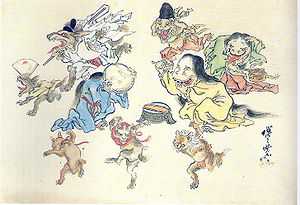Hyakki Yagyō

Hyakki Yagyō, variation: hyakki yakō, (百鬼夜行; lit. "Night Parade of One Hundred Demons"[2]) is a concept in Japanese folklore.
Definition
Legend has it that "every year yōkai led by the yokai Nurarihyon, will take to the streets during summer nights." Anyone who comes across the procession would die, "unless protected." Protection refers to handwritten scrolls by anti-yokai onmyoji spellcasters. Only an onmyoji clanhead is strong enough to pass Nurarihyon's Hyakki Yagyo unharmed.[3] The children's game Hyakumonogatari Kaidankai was based on this idea.[3]
In art
The night parade was a popular theme in Japanese visual art.[2]
One of the oldest and most famous examples is the 16th-century handscroll Hyakki Yagyō Zu (百鬼夜行図), erroneously attributed to Tosa Mitsunobu, located in the Shinju-an of Daitoku-ji, Kyoto.[2]
Other notable works in this motif include those by Toriyama Sekien (Gazu Hyakki Yagyō)[4] and Utagawa Yoshiiku. However, Toriyama's work presents yokai in separate, encyclopedic entries rather than assembled in a parade,[4] while Utagawa's "Kokkei Wanisshi-ki (Comical Record of Japanese History), employs the theme of 100 demons to comment on contemporary Japanese military actions in China."[5]
In the Ghibli movie Pom Poko, 'Operation Poltergeist' resembles a Hyakki Yagyō.[6]
References
- ↑ Clark, Timothy (1993). Demon of Painting: The Art of Kawanabe Kyosai. British Museum Press. p. 64. ISBN 0714114626.
- ↑ 2.0 2.1 2.2 Lillehoj, Elizabeth (1995). "Transfiguration: Man-Made Objects as Demons in Japanese Scrolls". Asian Folklore Studies 54 (1): 7–34. Retrieved 8 April 2013.
- ↑ 3.0 3.1 村上健司編著 『妖怪事典』毎日新聞社、2000年、288-289頁。ISBN 4-620-31428-5。
- ↑ 4.0 4.1 Foster, Michael Dylan (2009). Pandemonium and Parade: Japanese Demonology and the Culture of the Yōkai. University of California Press. p. 55.
- ↑ Lillehoj, Elizabeth. "Commentary". The Boone Collection. Retrieved 8 April 2013.
- ↑ "Cultural References in Manga". The Ohio State University Library Wiki. Retrieved 8 April 2013.
See also
- Gazu Hyakki Yagyō
- Gazu Hyakki Tsurezure Bukuro
- Konjaku Gazu Zoku Hyakki
- Konjaku Hyakki Shūi
- Nightmarchers
- Unseelie Court
- Wild Hunt